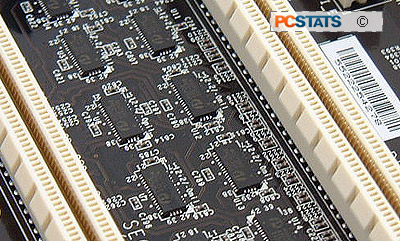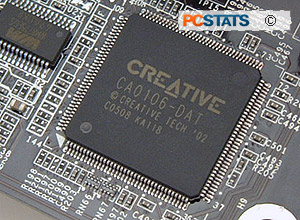Since the MSI P4N Diamond is based on the nForce4 SLI chipset, it obviously supports running two nVidia
GeForce 6xxx videocards in SLI mode. There is no physical switch on the
P4N Diamond motherboard for selecting SLI, rather the space between the two
PCI Express x16 slots is occupied by twelve Pericom chips which
automatically detect and split the PCI Express x16 bus equally.

The way nVIDIA implemented SLI on its NF4 SLI Intel
Edition chipset is a bit different than with the AMD version. When the first few
nF4-SLI (AMD) chipsets emerged, the physical SLI switch (or on switchless boards like the A8N-SLI Premium which also
use Pericom chips) divides the sixteen PCI Express into two groups. The first physical PCI Express
x16 channel gets PCI Express lanes 0-7 while the second gets lanes
8-15, a total of 8 lanes each. With the NF4 SLI Intel Edition version things are
slightly different. The first physical PCI Express x16 slot gets lane 0 and all
the even numbered lanes thereafter (ie. 0, 2, 4, 6, 8, 10,
12, 14) while the second physical PCI Express x16 slot gets all the odd numbered
lanes (ie. 1, 3, 5, 7, 9, 11, 13, 15).
This division of PCI Express lanes complicates
the digital switch design, and as we are aware MSI is currently the
only manufacturer who offers a physically switchless nForce4 SLI Intel Edition based
motherboard. During testing we did try and fool the board with a 7800GTX/6800GT combo
and X800 XT/7800GTX videocards setup, but the P4N Diamond was able to differentiate
between SLI and non SLI videocard configurations.
Creative Onboard Sound!
 In the
process of looking over every square inch of the MSI P4N Diamond, I was
delighted to discover a Creative CA0106-DAT hardware-base sound
controller. That MSI has implemented a hardware soundcards onto the P4N
Diamond instead of relying on software audio codecs is great, it handles both
sound quality and eases CPU load. Aside from nVIDIAs SoundStorm and perhaps
Intel's new Azalia codec, onboard AC'97 audio is nothing to get excited about.
If the audio controller processing is off loaded to the CPU, performance will
fall a couple points.
In the
process of looking over every square inch of the MSI P4N Diamond, I was
delighted to discover a Creative CA0106-DAT hardware-base sound
controller. That MSI has implemented a hardware soundcards onto the P4N
Diamond instead of relying on software audio codecs is great, it handles both
sound quality and eases CPU load. Aside from nVIDIAs SoundStorm and perhaps
Intel's new Azalia codec, onboard AC'97 audio is nothing to get excited about.
If the audio controller processing is off loaded to the CPU, performance will
fall a couple points.
With the P4N Diamond users have no need to upgrade
their sound card as the Creative Labs Live! 24 bit audio controller is pretty
good. On he rear I/O of the motherboard we find all the ports for 7.1 channel
audio operation as well as an SPDIF and optical ports.
The signal to noise ratio of the SoundBlaster Live! 24 bit is 100 dB which
is better than the typical AC'97 codec value between 76-90 dB or even Intel's
Azalia at 80-94 dB. The DAC/ADC resolution of the Creative soundcard is 24 bits
while the typical onboard audio solutions are 16 bit. SPDIF output quality can go
as high as 24 bit resolution, with a selectable sampling rate of 44.1, 44 and 96
kHz.
Unless you are doing some sort of professional audio editing, the onboard
SoundBlaster Live! 24 bit on the MSI P4N Diamond does not need to be
replaced.
